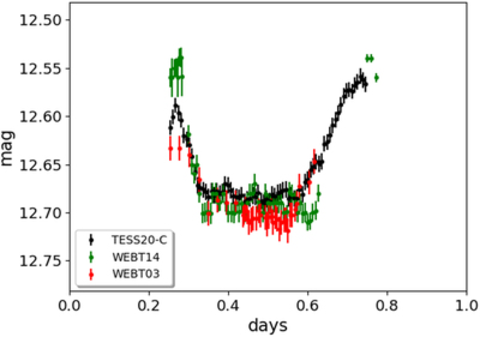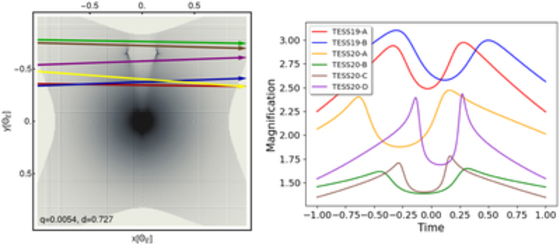Astronomy Object of the Month: 2023, April
< previous Archive next >
Gravitational lensing of blazar S5 0716+714
Blazars are a class of active galaxies whose jets (relativistic streams) are directed toward an Earth-based observer. They are characterized by high variability in luminosity, observed in various ranges of electromagnetic radiation (from radio to gamma rays) and on different time scales - from minutes to tens or even hundreds of years.

Illustration 1: The variation in object luminosity across three different observations. Credit: The Authors.
One of the well-known blazars is 0716+714. It has earned its fame among astronomers for its particularly high variability in the optical range of radiation, on time scales of the order of single nights. This makes it a great target for observing campaigns such as WEBT (Whole Earth Blazar Telescope), continuously monitoring the variability of blazars for several days in a row. Two WEBT datasets from 2003 and 2014 showed the characteristic pattern of blazar luminosity variation observed in each of the telescope's filters (Fig.1, green and red).
The object was also recently observed by the Transiting Exoplanet Survey Satellite (TESS), which provided us with its light curves for a total of 120 days. We have found several other manifestations of variability in it, with the same characteristics (Fig.1, black). This type of variability pattern is hard to relate to the currently known processes occurring in blazars.

Illustration 2: On the left we present the trajectories of the source on the lensing plane, on the right – the corresponding light curves.
Credit: The Authors.
We postulate in our work that the variability of the blazar, as observed several times, may be related to gravitational lensing of segments of its jet by a binary system located in the blazar's home galaxy. Gravitational lensing is the physical phenomenon of bending the course of light rays near massive objects by curving the space-time itself. This leads to their focusing, which, depending on the mass, configuration and mutual distances of the lens, observer and source, manifests itself in our observations in different ways. The lens, which is a binary system that passes in front of the line connecting the distant source to the observer, can trigger luminosity changes of precisely the type we observe in the luminosity light curve of S5 0716+714 blazar.
The results of our modelling show that this type of variation can be explained by the lens being a binary system consisting of a central main mass and an approximately 100 times less massive companion. The mass of the binary system depends on its position in the blazar's parent galaxy. Using the constraints imposed on the system due to the duration of events and the period between the first and last observations of the phenomenon, we obtain a mass of the lens that ranges from 104 to 106 solar masses. This could mean that the lens is a black hole of intermediate mass, that is, larger than the stellar-mass black holes formed as the final stage in the evolution of the most massive stars, and much smaller than the supermassive black holes observed in the centers of galaxies.
Original publication: D. Król et al., Possible Gravitational Microlensing Events in the Optical Lightcurve of Active Galaxy S5 0716+714, The Astrophysical Journal 943 (2023).
The research was conducted at the Department of High Energy Astrophysics of the Jagiellonian University’s Astronomical Observatory (OA UJ).
|
Dominika Król Astronomical Observatory Jagiellonian University D.Krol [@] oa.uj.edu.pl |


